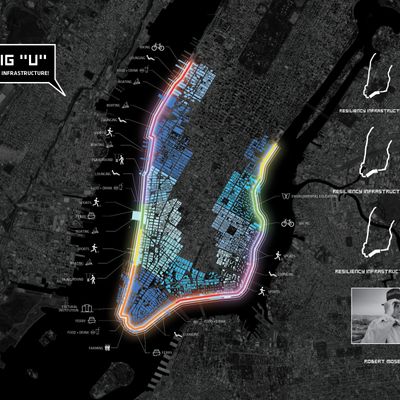
If Hurricane Sandy slammed into New York again tomorrow, the city might fare somewhat better than it did in 2012, but we’d surely recognize the flooded highways, blacked-out neighborhoods, and crippled subways. There’s a chance, though, that by the time the next great storm menaces, we’ll watch it roll in from atop a necklace of landscaped mounds stretching around Manhattan’s lower third. Or we might see the surging waters stumble on oyster reefs off the southern shore of Staten Island, or ease calmly into a ready Hoboken and seep slowly and safely back out. Maybe, when the weather’s less threatening, new riverside slopes along the Lower East Side will flank the FDR Drive, provide the topography for meandering park paths, and anchor a new aquarium in Battery Park. That vision of a verdant buffer zone between the city and the rising waters all around may still be a fantasy — only now it’s a fantasy fueled by hundreds of million of dollars.
For the past year, Rebuild by Design, a competition looking for ways to protect the coasts from extreme weather and rising seas, has quietly sent teams of architects and engineers around New York and New Jersey looking for ways to spend close to $1 billion in federal community development block grants. The keeper of the purse strings was Shaun Donovan, the Obama administration’s housing secretary and Sandy reconstruction czar, who recently became budget chief — and it was Donovan who popped up yesterday to announce the awards: $355 million for those lower Manhattan berms, designed by the Danish architecture firm BIG and its partners; $230 million for a full package of strategies to protect Hoboken, from a team led by the Dutch firm OMA; $60 million for those Staten Island reefs; $20 million for a plan to safeguard the Hunts Point Market — and so on.
Even with all that promised money, pushing some of these projects closer to reality won’t be easy. In Hoboken, public funds will need to leverage a much larger pile of private investment, which makes the plan vulnerable to economic fluctuations. The Manhattan project, a multi-stage piece of green riverside infrastructure, will mean whipping together a fractious choir of bureaucrats, community boards, the Army Corps of Engineers, activists, obstructionists, NIMBYites, and environmentalists. Still, Henk Ovink, the tireless Dutch water management expert who runs the program, claims to relish the obstacles. Besides, Rebuild by Design emerged from exhaustive discussions with all parties, so nobody should feel like a project is being sprung on them. The battles, lawsuits, and setbacks will come anyway, but Ovink thinks that’s fine. “Most developers like to pull a rabbit out of a big hat. We wanted to prevent those surprise acts,” he says. “We’re changing people’s futures and we don’t want it to be too easy. That would be weird.”






























